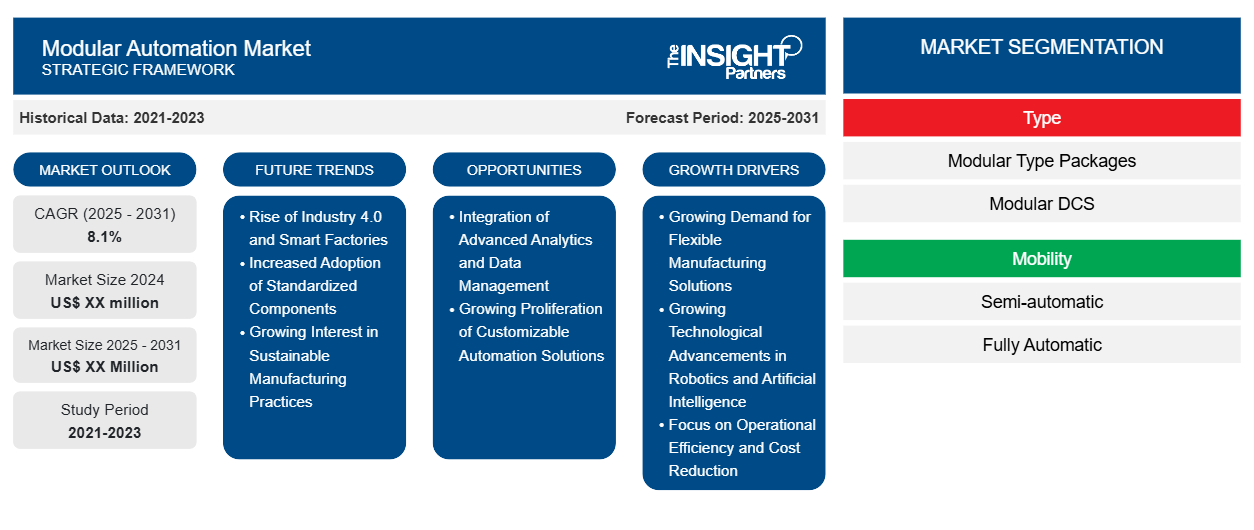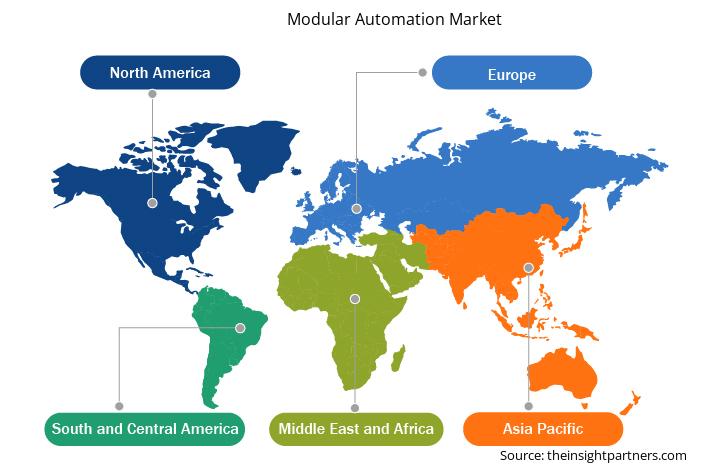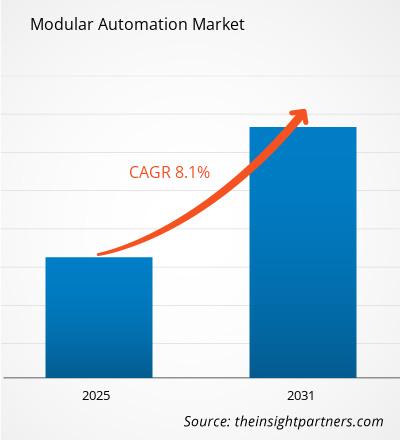预计模块化自动化市场在 2025 年至 2031 年期间的复合年增长率为 8.1%,市场规模将从 2024 年的 XX 百万美元扩大到 2031 年的 XX 百万美元。
该报告按类型(模块化套件、模块化DCS)、移动性(半自动、全自动)、组件(机器人控制器、I/O模块、驱动器和电机、传感器和执行器、安全)、最终用户行业(制药、化工、食品饮料、物流和仓储、其他)进行细分。全球分析进一步细分为区域和主要国家。报告提供上述分析和细分的美元价值。
报告目的
Insight Partners 发布的《模块化自动化市场》报告旨在描述模块化自动化市场的现状和未来增长、主要驱动因素、挑战和机遇。该报告将为各业务利益相关者提供洞见,例如:
- 技术提供商/制造商:了解不断变化的市场动态并了解潜在的增长机会,从而能够做出明智的战略决策。
- 投资者:对市场增长率、市场财务预测以及整个价值链中存在的机会进行全面的趋势分析。
- 监管机构:监管市场政策和警察活动,旨在最大限度地减少滥用行为,维护投资者的信任和信心,维护市场的完整性和稳定性。
模块化自动化市场细分
类型
- 模块化封装
- 模块化DCS
移动性
- 半自动
- 全自动
成分
- 机器人控制器
- I/O模块
- 驱动器和电机
- 传感器和执行器
- 安全
终端用户行业
- 制药
- 化学
- 食品和饮料
- 物流和仓储
定制此报告以满足您的需求
您可以免费定制任何报告,包括本报告的部分内容、国家级分析、Excel 数据包,以及为初创企业和大学提供优惠和折扣
模块化自动化市场:战略洞察

- 获取此报告的关键市场趋势。这个免费样品将包括数据分析,从市场趋势到估计和预测。
模块化自动化市场增长动力
- 柔性制造解决方案需求不断增长:模块化自动化市场主要受到日益增长的柔性制造系统需求的驱动,这些系统能够适应不断变化的生产需求。各行各业都在寻求提高运营效率和减少停机时间的方法。模块化自动化可以快速重新配置生产线和设备,使制造商能够快速响应市场需求、产品变化和不断变化的消费者偏好。对于希望在当今瞬息万变的市场环境中保持竞争优势的公司来说,这种适应性至关重要。
- 机器人技术和人工智能技术日新月异:机器人技术、人工智能 (AI) 和机器学习的快速发展正在推动模块化自动化市场的发展。这些技术的创新推动了更智能、更自主的模块化系统的开发,使其能够在极少的人工干预下执行复杂的任务。智能算法的集成增强了流程优化、预测性维护和质量控制,从而提高了生产力并降低了运营成本。随着这些技术的不断发展,它们将进一步推动各行各业对模块化自动化解决方案的采用。
- 注重运营效率和成本削减:随着优化生产流程和降低成本的压力日益增大,企业正将模块化自动化视为一种可行的解决方案。模块化系统具备可扩展性,使企业能够逐步投资自动化,而无需投资于大型固定系统。这种灵活性有助于企业最大限度地降低资本支出,同时最大限度地提高投资回报。此外,简化工作流程和自动化重复任务的能力能够提高整体运营效率,因此对于希望提高盈利能力的企业来说,模块化自动化是一个极具吸引力的选择。
模块化自动化市场未来趋势
- 工业 4.0 和智能工厂的兴起:模块化自动化市场正见证着迈向工业 4.0 的重要趋势,其特点是物联网 (IoT) 技术与智能工厂理念的融合。这一趋势强调机器、系统和人工操作员之间的实时数据交换和连接。模块化自动化系统越来越多地被设计为与物联网设备兼容,从而提高生产流程的可视性和控制力。随着企业努力打造智能工厂,对促进这一转型的模块化自动化解决方案的需求预计将持续增长。
- 标准化组件的采用率不断提升:模块化自动化市场的一个显著趋势是向标准化组件和系统迈进。标准化降低了复杂性,增强了不同自动化解决方案之间的兼容性,使制造商能够更轻松地将各种系统集成到其运营中。这一趋势不仅简化了设计和实施流程,也简化了维护和升级。随着企业优先考虑高效且经济的自动化解决方案,对采用标准化组件的模块化系统的需求可能会不断增长。
- 对可持续制造实践的兴趣日益浓厚:随着可持续性成为各行各业关注的重点,模块化自动化市场正在积极适应这些环境目标。模块化自动化解决方案通常旨在优化资源利用、减少浪费和降低能耗,并与可持续制造实践保持一致。企业越来越认识到环保运营的重要性,这催生了一种趋势,即利用模块化自动化同时实现运营效率和可持续性目标。这种双重关注提升了模块化系统在各个领域的吸引力。
模块化自动化市场机遇
- 高级分析与数据管理的集成:随着企业寻求利用数据进行更明智的决策,集成高级分析和数据管理功能的模块化自动化解决方案的市场机会日益增多。通过将数据分析集成到模块化系统中,企业可以深入了解生产性能、识别瓶颈并优化流程。这种数据驱动型自动化解决方案的趋势为开发人员提供了一个有利可图的机会,使他们能够创建创新的模块化系统,从而提高运营效率并支持持续改进计划。
- 可定制自动化解决方案日益普及:高度可定制自动化解决方案的需求日益增长,为模块化自动化市场的参与者提供了巨大的机遇。企业正在寻找能够根据其特定需求量身定制的自动化系统,从而提高生产流程的灵活性和效率。通过提供可根据独特需求轻松定制和配置的模块化自动化解决方案,企业可以占领更大的市场份额,并通过增强的服务产品来建立长期的客户关系。
模块化自动化市场区域洞察
Insight Partners 的分析师已详尽阐述了预测期内影响模块化自动化市场的区域趋势和因素。本节还讨论了北美、欧洲、亚太地区、中东和非洲以及南美和中美的模块化自动化市场细分和地域分布。

- 获取模块化自动化市场的区域特定数据
模块化自动化市场报告范围
| 报告属性 | 细节 |
|---|---|
| 2024 年的市场规模 | XX 百万美元 |
| 2031 年市场规模 | XX 百万美元 |
| 全球复合年增长率(2025 - 2031) | 8.1% |
| 史料 | 2021-2023 |
| 预测期 | 2025-2031 |
| 涵盖的领域 | 按类型
|
| 覆盖地区和国家 | 北美
|
| 市场领导者和主要公司简介 |
|
模块化自动化市场参与者密度:了解其对业务动态的影响
模块化自动化市场正在快速增长,这得益于终端用户需求的不断增长,而这些需求的驱动因素包括消费者偏好的演变、技术进步以及对产品优势的认知度的提升。随着需求的增长,企业正在扩展产品线,不断创新以满足消费者需求,并抓住新兴趋势,从而进一步推动市场增长。
市场参与者密度是指在特定市场或行业内运营的企业或公司的分布情况。它表明在给定市场空间中,相对于其规模或总市场价值,有多少竞争对手(市场参与者)存在。
模块化自动化市场的主要公司有:
- ABB
- 西门子
- 费斯托公司
- 横河电机
- 希马
免责声明:上面列出的公司没有按照任何特定顺序排列。

- 获取模块化自动化市场顶级关键参与者概览
主要卖点
- 全面覆盖:该报告全面涵盖了模块化自动化市场的产品、服务、类型和最终用户的分析,提供了整体概况。
- 专家分析:报告基于对行业专家和分析师的深入了解而编写。
- 最新信息:该报告涵盖了最新信息和数据趋势,确保了其与业务的相关性。
- 定制选项:此报告可以定制以满足特定客户要求并恰当地适应业务策略。
因此,模块化自动化市场研究报告有助于引领解读和理解行业现状及增长前景。尽管存在一些合理的担忧,但本报告的总体优势往往大于劣势。
- 历史分析(2 年)、基准年、预测(7 年)及复合年增长率
- PEST和SWOT分析
- 市场规模、价值/数量 - 全球、区域、国家
- 行业和竞争格局
- Excel 数据集
近期报告
客户评价
购买理由
- 明智的决策
- 了解市场动态
- 竞争分析
- 客户洞察
- 市场预测
- 风险规避
- 战略规划
- 投资论证
- 识别新兴市场
- 优化营销策略
- 提升运营效率
- 顺应监管趋势




















 获取免费样品 - 模块化自动化市场
获取免费样品 - 模块化自动化市场